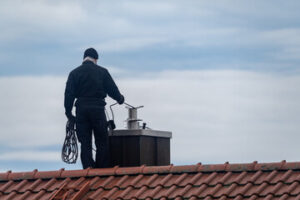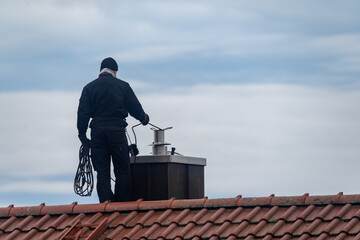A chimney sweep can perform an inspection and cleaning of your fireplace. They may begin indoors or on the roof and scrape any coatings like creosote.
Traditionally, master chimney sweeps took in orphan children or purchased them from poverty-stricken parents as so-called chimney sweep apprentices. They were nothing less than indentured servants and were harshly treated. Visit https://chimneysweepcharleston.com/ for more information.
As a profession, chimney sweeps are expected to adhere to certain safety standards. This includes ensuring that they have appropriate equipment for working on a roof and understanding the proper use of ladders. It’s also important that they be aware of any potential fire hazards that may exist inside the fireplace and chimney system.
A chimney sweeper should always wear a respirator when cleaning a fireplace or chimney. This is because they are dealing with harmful vapors, soot and dust that can be irritating to the lungs. It’s also important that they take the time to put on a mask when they are climbing up in the chimney to clean out the creosote.
Chimney sweeps should also ensure that they have adequate insurance coverage to protect their customers in the event of an accident. It’s worth checking with your local fire department to see what types of liability insurance is required for chimney sweeps to work in homes.
A reputable chimney sweep will be able to provide you with a report after their inspection and sweeping is complete. This should include any observations they have made and recommendations for repair. They should also be able to answer any questions you might have about the condition of your chimney and fireplace.
It is also a good idea to move any furniture that is close to the fireplace back a few feet and cover it with plastic or a cloth. This will help to prevent any ash or debris from falling on your carpets and other items in your home. It’s also a good idea to have a few extra brooms on hand to sweep up any debris that has fallen on the floor.
Tools
A chimney sweep needs to have a variety of tools to perform their job. These include brushes to scrape away creosote, power vacuums to clean up ash, chimney caps and spark arrestor installations, specialized equipment for inspecting chimneys, and even software tools for route optimization. It’s important for chimney sweeps to be well-equipped before embarking on this career because their tools will help them keep up with client demands while keeping them safe.
A face respirator is also a must for chimney sweeps, since it prevents them from breathing in hazardous chemicals as they work on their clients’ homes. A filtered vacuum system is also helpful, since it helps them avoid contaminating their customers’ homes with airborne toxins. This type of filtration system typically has a metal hose that can resist heat from burning coals, making it suitable for use in combustible environments.
Chimney sweeps also have to be prepared for unexpected surprises. For example, chimneys are sometimes used as nesting places for animals, and they need to be able to remove those critters from the structures safely. In addition, many homeowners don’t realize that their chimneys can be clogged with things like toys, tools, and love letters, which are flammable and need to be removed as soon as possible.
The job of a chimney sweep is physically demanding, and it’s not uncommon for them to be covered in dirt and soot from head to toe. It’s essential for chimney sweeps to take breaks throughout their shifts and avoid pushing themselves beyond their stamina limits. This can help them stay alert and focused on the tasks at hand. Taking frequent breaks will also help them stay hydrated and energized for longer, ensuring their safety as they climb up to the roofs of their clients’ homes.
Clean-up
A chimney sweep has to be comfortable working in tight spaces. Oftentimes, they will be climbing on roofs to conduct inspections of heating systems and fireplaces. Depending on the type of home, they may have to enter crawl spaces or even climb down into the chimney itself. Being claustrophobic or having a fear of heights can make this type of work extremely difficult, if not impossible.
The chimney sweeping process can produce a lot of dust, so it’s important for homeowners to cover their floors with a tarp before the sweep arrives. This will help protect your furniture and other items from getting covered in soot and dirt. It is also helpful to move any items that are on or near the fireplace area, so they aren’t in the way during the cleaning process.
When the chimney sweep arrives, they will start by making an inspection of the fireplace and chimney. If they determine that it is time for a cleaning, they will begin sweeping the chimney with brushes and extension poles. They will also use a shop vacuum to clean out the chimney cavity and flue.
The CSIA recommends that homeowners have their chimneys cleaned at least once every year to prevent a dangerous build-up of creosote. This build-up is highly flammable, and if it gets too thick, it can cause chimney fires. The best time to have the chimney swept is during the late summer or early fall before starting up the fires again for the winter season. It’s also recommended that homeowners schedule the chimney sweep for their routine chimney maintenance at the same time as they get their furnaces inspected each year.
Creatures
In addition to cleaning chimneys, sweeps may be called upon to help homeowners deal with wild animals. Raccoons, squirrels, birds, and other critters often crawl into chimneys to escape from the elements or find a place to nest. These animals can cause serious problems for homeowners. They can clog the chimney with their droppings and other debris, or they can build nests that block the flue. This can cause carbon monoxide to back up into the home. It can also prevent the flue from venting properly, which could lead to a fire.
Some animals may have to be removed by hand or with a net and broom. In these situations, a chimney sweep will wear safety goggles and cover their face with a mask. They will remove the animal and clean up the debris and nesting materials that it leaves behind. The animal will then be released in a safer area away from the house.
Another type of animal that can invade a home is a bat. These creatures can carry rabies and other diseases that pose real dangers to people. They can also clog the chimney with their guano, which restricts exhaust air flow. Chimney sweeps can humanely drive bats out of chimneys and remove their guano as well.
Other types of animals that can be swept up with a chimney sweep include mice and other rodents, possums, and rabbits. These animals can cause a great deal of damage and may even be fatal to humans if they get into a home or business. They can also contaminate the inside of the home with their droppings and urine, as well as feces and decaying carcasses. This can lead to respiratory issues, allergic reactions, and a variety of other illnesses.
Pay
Most chimney sweeps work as independent contractors, so the ability to generate a client base is key. This can involve door-to-door conversations, local advertising and social media marketing. A chimney sweep’s income may vary, but they must be able to stash away cash to cover leaner months. Chimney sweeps must also be able to balance their business finances, so they can invest in the necessary tools and equipment that will help them perform their work.
A chimney sweep will begin by inspecting the fireplace and chimney system to determine if it is safe for use. They will then begin the cleaning process, which involves sweeping and vacuuming the chimney of all accumulated creosote glaze and debris that has built up on the chimney lining from previous fires. The chimney sweep will then scrape the chimney lining and remove any blockages or other issues that need to be addressed.
If the chimney is deemed unsafe, the chimney sweep will recommend that the customer contact their local building inspector for further inspection and possible repairs or replacements. A chimney sweep can also recommend other home improvement services, such as repairing or replacing a chimney cap, installing a new fireplace insert and relining a flue.
The chimney sweep will then invoice the customer for the work performed. This can be done using a standard sales tax or other applicable taxes and fees, depending on the local governing authorities where the customer lives. Chimney sweeps typically accept cash, checks or credit card payments. Some companies also offer financing options that allow customers to pay for chimney maintenance and repair services over time, which can be helpful to those who may not be able to afford to make a lump sum payment.
